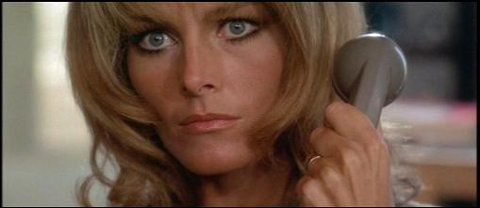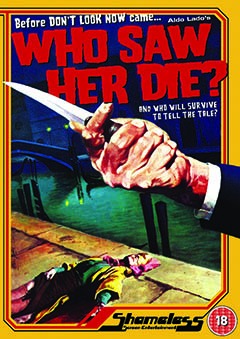Who Saw Her Die? review by Matt Fuerst
@JackassMatt
I've got a fairly serious dirty little secret I'm going to share in the following paragraphs. What I'm about to admit certainly shines a dark light on me as a person, so it's pretty embarrassing airing this dirty laundry in such a public manner. But, I'm counting on a few factors to let this one slide; Most importantly, the very limited traffic that Jackass Critics is seeing these days. Without further ado, here we go: I don't particularly like red headed children. My distaste for the gingers extends to fully grown adults, don't get me wrong, but the ankle biting red heads, man... they really get under my skin. Now, before you judge me, let me dig myself a little deeper of a hole. I have no particular reason to dislike the freckled fiends that walk amongst us. No red headed baby ever barfed up on me, I wasn't beaten up by "Eric the Red" in elementary school, and no red headed kids stole my girlfriend in high school. My distaste is seemingly purely genetic, bred into me over thousands of years of highly selective, red-head-hating partners mating and producing offspring. I can't help myself, people. I, at least, have taken the first step of breaking this vicious cycle by coming clean here in a public forum.What this discussion has to do with a 70's Italian giallo, you are about to find out. Who Saw Her Die? can't possibly be accused of having a subtle title. And when the first 10 seconds of the film shows you a little girl in the woods getting separated from her mother, you've got a pretty good idea what is about to happen to her. Said little girl in the scene has one very distinctive feature - firey red hair. So, I found myself at an emotional crossroads. My instincts initially cried "get that red headed beast off the screen!", yet I knew a grisly fate was likely soon to overcome the little brat.
It may be time for yet another diversion (I hear your groans, seeing as we are a full 3 paragraphs into my synopsis, yet I haven't progressed passed the first 30 seconds of the film). Here's a hot potato of a topic: Child murder in films. How often do you see that? It's pretty rare, and pretty taboo. Proving how fast my Internet-Destroyed mind can switch gears, nearly as soon as I got over the red-headed-ness of the papoose on screen, I debated, "How explicitly are they going to whack the brat?". Didn't have to wait long for that one, our antagonist wrenches the kid in a headlock, grabs a rock and bashes the skull in.
Wow.
Apparently, someone likes red headed kids a lot less than I do. While not as explicit as something from a modern day Saw film, it's still pretty out there to watch on screen. So, within the first 2 minutes, we have a lot of information on what sort of film Who Saw Her Die? is going to be. "It pulled too many punches" isn't going to be something I will end up accusing it of.
These thoughts out of the way, let me give you a rundown of the rest of the flick (watch me maintain a laserlike focus for at least the next 2 paragraphs). During the murder sequence, we get brief glimpses of the antagonist: it appears to be a lady dressed all in black, with a black veil over her face. In true giallo fashion, we do get some first person shots from inside the veil, and the murderer stalks her prey. After the initial murder, we are given the credit sequence, and the film flashes forwards 4 years and switches our setting from the initial French countryside to a village in Italy. We are introduced to sculptor Franco Serpieri (played by the one and only George Lazenby of James Bond fame) and his daughter Roberta. If you've gone ahead and jumped to the conclusion that Roberta may be blessed (or cursed) with a dominant red headed hair gene, you'd be right on (and if you didn't jump to this conclusion, you are a very passive reader).
 Franco and his wife Elizabeth (played by the amazingly beautiful Anita Stringberg) are having a trouble, and Elizabeth decided to stay back in her homeland of England, while Roberta visited her father. We are presented with some very effective moments of Franco and Roberta spending time together. I generally find scenes like these (early character bonding) are generally thrown together in a routine fashion, but Who Saw Her Die? actually does an excellent job. After all the horrible things I've said about red heads, I fully expected to gleefully anticipate the demise of young Roberta, but the father and daughter dynamic is actually convincingly portrayed, and I found myself surprised as can be that I actually bonded with Roberta and her father.
Franco and his wife Elizabeth (played by the amazingly beautiful Anita Stringberg) are having a trouble, and Elizabeth decided to stay back in her homeland of England, while Roberta visited her father. We are presented with some very effective moments of Franco and Roberta spending time together. I generally find scenes like these (early character bonding) are generally thrown together in a routine fashion, but Who Saw Her Die? actually does an excellent job. After all the horrible things I've said about red heads, I fully expected to gleefully anticipate the demise of young Roberta, but the father and daughter dynamic is actually convincingly portrayed, and I found myself surprised as can be that I actually bonded with Roberta and her father.
Thus, I genuinely felt a sense a dread when a scene depicting Roberta gleefully playing with her friends in the village square was interrupted by the first person shot from behind the veil of the killer. I knew this was coming, it was just a matter of when, but I didn't expect to be so disappointed that Roberta was about to meet her demise. Director Aldo Lado plays this dread pitch perfect, as our killer comes close, and is foiled several times in their attempts to snatch up Roberta. Lado mixes together the first person perspective, the innocence of Roberta, the cute Italian village with some wonderful audio work (successfully blending in loud, overpowering pieces with silence and quiet passages) to really keep a viewer on the edge of their seats.
Eventually, the inevitable happens, and Roberta is snatched away. The movie enters into it's 2nd act, and alas, Who Saw Her Die? really gets weaker from this point on. Franco is reunited with his wife Elizabeth (did I mention how unbelievably beautiful Anita Strinberg is? I did, but I am intentionally mentioning it again, and that was the only device I could quickly think of to bring it up again) and it's really their show from this point forward. We're left with Franco attempting to puzzle out what exactly happened to his daughter. The 2nd act isn't all bad, there is actually a pretty interesting cast of characters that Franco interrogates, trying to piece together clues. If you aren't familiar with giallos (a genre of Italian horror/mystery/thriller films), it's handy to note that traditionally while the identity of the antagonist is a mystery, it is generally a member of the cast of characters. So, we know that someone Franco is dealing with killed his daughter, but who is it?
Each time Franco leaves a room, we see a character picking up a phone and calling someone mysterious, or moving offscreen to consult with someone hidden in the wings. What sort of vast conspiracy is going on here? As the movie wraps up, we're left with a somewhat unsatisfying finish to what was a great start. This isn't uncommon, it's hard for the last sip of your can of Coke to taste as good as the first, but it really did make me wish that a little more script work was done with the finale, and that Franco (Lazenby pulling his best George Harrison physical impersonation) could pulling off emoting a little better.
Who Saw Her Die? seems to be pretty overlooked in the giallo genre. I think it's an excellent example of the giallo genre, and truly succeeds as a great piece of art even outside of the giallo genre. Aldo Lado made use of his quaint setting to great effect, got good acting from his actors and once again, the sound design really deserves praise. It's rare for me to make note of sound design and music, but it's present here and really had an impact on me as a viewer.
I would suggest this film as being good for a more general audience since it has a lot of mainstream elements to it. Lazenby is a native English speaker, so all of his dialogue is delivered naturally, without any dubbing concerns. A lot of the more, unusual elements of a giallo are not really present here. In all honesty, aside from the initial opening sequence, there is very little violence present. After that point, the movie shifts more into thriller and detective modes.
I find it impressive when a movie is able to overcome my initial reactions, and actually manages to change my mind. It's pretty rare for a film to actually engage you at that level, let alone actually take you on a bit of a journey where you feel attaches to the characters. I felt that here, especially for the first half of the movie, but it's worth sticking around to the end.








8 out of 10 Jackasses blog comments powered by Disqus
